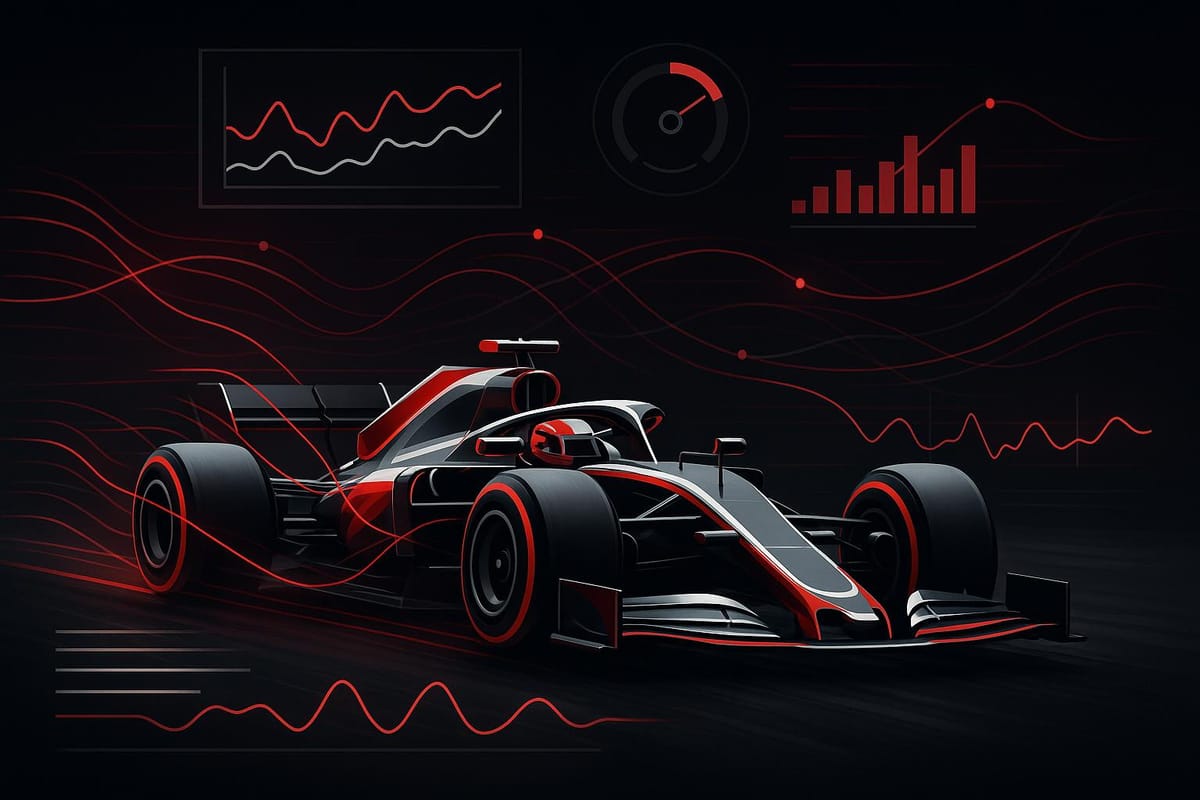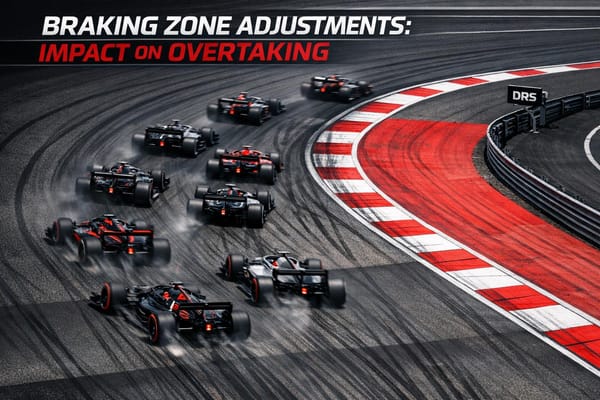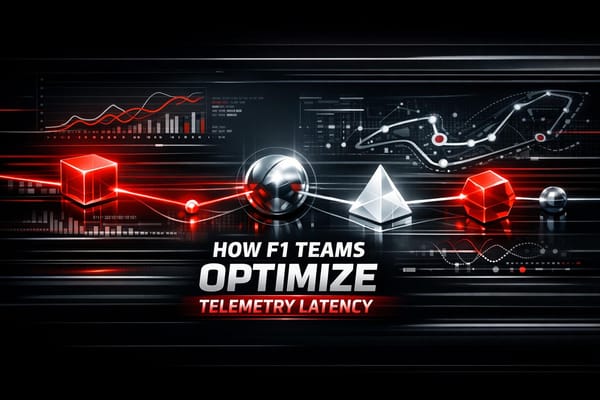Future of F1 Broadcasting with Real-Time Data
Explore how real-time data and advanced technologies are transforming Formula 1 broadcasting, enhancing fan engagement and race-day experiences.

Formula 1 broadcasting has evolved into a data-rich experience that changes how fans watch and interact with races. By integrating real-time telemetry, cloud-based analytics, and interactive platforms, F1 offers deeper insights into race strategies, driver performance, and team decisions. Here's what you need to know:
- Real-Time Data: Modern F1 cars use 300+ sensors to provide live metrics like speed, tire wear, and fuel usage, enabling broadcasters to explain race dynamics in detail.
- Second-Screen Apps: Tools like F1 Live Timing let fans access telemetry, sector splits, and strategy updates while watching races.
- Cloud Computing: AWS processes over 1M data points per second, powering features like driver battle analysis and championship predictions.
- Interactive Features: Fantasy leagues, prediction games, and social media enhance fan engagement and offer new revenue opportunities.
- Emerging Technologies: AR, VR, and AI are reshaping how races are experienced, providing immersive cockpit views and predictive analytics.
This shift to data-driven coverage has boosted F1’s popularity, especially in the U.S., where viewership hit a record 1.4 million per race in 2025. Younger fans, particularly Gen Z, are drawn to these interactive experiences, with 70% engaging with F1 content daily. Partnerships like F1’s upcoming exclusive deal with Apple promise even more personalized and engaging broadcasts.
Key takeaway: Real-time data is now central to F1's storytelling, connecting fans to the sport with unprecedented depth and interactivity.
Telemetry | Empowering F1 race with a real-time data & insights
Current Real-Time Data Technologies in F1
Modern Formula 1 broadcasting is built on cutting-edge systems that gather, process, and deliver vast amounts of live data in real time. From sensors embedded in the cars to advanced cloud-based analytics, these technologies are transforming how fans experience the sport.
Telemetry and Live Timing Data
F1's broadcasts rely heavily on telemetry systems to provide a data-rich narrative of every race. Each car is equipped with 300 sensors that track everything from speed and tire temperature to brake wear, fuel consumption, and engine performance. This data is transmitted wirelessly in real time to both teams and broadcasters, forming the foundation of race-day coverage.
Live timing data complements telemetry by offering up-to-the-second updates on lap times, sector splits, pit stop durations, and position changes. Together, these systems allow fans to dive deeper into the strategies and dynamics of a race. Broadcasters can go beyond simply describing what’s happening on track to explaining why it’s happening.
For example, when a driver makes a daring overtaking move, broadcasters can instantly display metrics like speed differences and tire conditions that made the pass possible. During pit stops, viewers gain insight into tire degradation patterns and fuel load calculations, making complex strategies more accessible and engaging.
AWS and Cloud Computing in F1
Amazon Web Services (AWS) has revolutionized F1's data processing capabilities as the sport’s official cloud computing partner. During live races, AWS processes over one million data points per second, enabling the advanced analytics that make today’s broadcasts so dynamic.
Key tools like F1 Insights and Track Pulse run on AWS’s platform, providing real-time predictions, driver battle analysis, and performance metrics. These tools simplify massive amounts of data into intuitive dashboards, helping broadcasters quickly identify and share the most intriguing storylines without overwhelming viewers.
Cloud computing offers distinct advantages over traditional methods. AWS can scale its computing power instantly during race weekends, ensuring no delays even with the enormous data load. This setup allows real-time insights to be shared with multiple broadcasters across different time zones. Tools like Track Pulse also provide instant updates on driver battles, championship predictions, and sector times, helping fans stay connected to every twist and turn of the race.
How Data Changes Race-Day Storytelling
The integration of real-time data has redefined how F1 races are narrated. Rather than reacting to on-track events, commentators now use data to provide proactive storytelling. They explain the factors driving race dynamics and even predict future developments based on live trends.
For instance, during an intense on-track battle, broadcasters can display comparisons of tire wear, speed through specific corners, or pit strategy predictions. If Max Verstappen is closing in on a rival, viewers might see the conditions leading up to the overtake before it even happens.
Real-time data also enhances strategic analysis. Broadcasters can present fuel usage estimates, tire performance projections, and track position scenarios as they unfold, allowing fans to follow the same calculations teams use to make critical decisions. This data-driven approach extends beyond individual races, enriching season-long narratives. Championship battles become even more engaging when viewers can track live points scenarios, required finishing positions, and potential outcomes.
The impact of this storytelling approach is clear. The 2025 season drew an average of 1.4 million viewers per race in the U.S., a record-breaking figure that highlights how deeper engagement through data resonates with modern audiences.
Interactive and Second-Screen Experiences
F1 fans now enjoy a richer viewing experience by engaging across multiple screens, blending real-time data with interactive tools. This evolution goes hand-in-hand with the sport's growing emphasis on live data, transforming how fans connect with races beyond traditional broadcasts.
Second-Screen Apps and Platforms
Leading the charge in second-screen experiences is F1 Live Timing, which offers fans an in-depth look at races through real-time telemetry, sector breakdowns, driver radio exchanges, and track position updates. Features like split-screen modes and interactive overlays allow viewers to follow race strategies while watching the broadcast. It's no surprise that three out of four F1 fans now use at least one digital platform to stay connected with the sport.
Beyond live race tracking, companion platforms have introduced features like fantasy leagues, race predictions, and mobile gaming. These tools integrate live stats and customizable dashboards, letting fans spotlight their favorite drivers or focus on specific race strategies. It's all about tailoring the experience to individual preferences, making F1 more interactive than ever.
Gamification and Fan Predictions
Fantasy leagues and prediction games have turned watching races into an active, participatory experience. The official F1 fantasy league invites fans to assemble virtual teams and make strategic decisions based on expected performance. Meanwhile, third-party apps offer prediction games where fans can guess race outcomes, pit stop timings, or tire strategies. These gamified elements not only enhance engagement but also align perfectly with F1's data-driven storytelling.
Engagement data backs up this trend: 70% of Gen Z respondents in the 2025 Global Fan Survey interact with F1 content daily, often focusing on individual drivers rather than teams. Prediction tools keep fans engaged throughout the race weekend, turning every moment into an opportunity for involvement.
Social Media and Real-Time Interaction
Social media has added another layer to F1's interactive ecosystem, creating a space for live discussions and reactions. Platforms like X (formerly Twitter) and TikTok allow fans to share instant reactions to race events, often outpacing traditional broadcast commentary. This dynamic exchange has become a parallel commentary stream, offering diverse insights and immediate feedback.
Teams and drivers also use platforms like X and TikTok to share behind-the-scenes content and strategic updates, strengthening their connection with fans. This approach has been particularly effective in engaging female audiences. For instance, McLaren Racing saw its female audience share grow from 28.5% to 50.4% between May 2023 and May 2024, largely thanks to engaging social media content. These numbers highlight how interactive and diverse content is broadening F1's reach.
Emerging Technologies in F1 Broadcasting
F1 broadcasting is stepping into a new era, building on its strong foundation of real-time data integration. These advancements are reshaping how fans experience the sport, offering immersive features and smart automation that bring viewers closer to the action.
Virtual Reality (VR) and Augmented Reality (AR)
VR and AR are breaking new ground in F1 broadcasting, creating interactive and engaging race-day experiences. With AR overlays, fans can see live telemetry, driver stats, and race positions directly on their screens or headsets. Imagine using your smartphone during a race to access detailed metrics like tire wear or sector times - just by interacting with the broadcast. On the VR side, experiences like virtual pit walks or cockpit views let fans feel like they’re right at the track, all without leaving their homes. Pilot programs testing these features are already in motion, hinting at a future where fans can engage with races in ways previously unimaginable.
AI is also stepping into the spotlight, transforming how race analytics are delivered.
Generative AI and Predictive Analytics
Generative AI is revolutionizing race coverage by automating highlights, commentary, and predictive insights. Tools powered by AWS, such as Track Pulse and F1 Insights, now use AI to pinpoint pivotal moments and predict race outcomes. This adds a new layer of excitement and context to every lap, making the viewing experience even more dynamic.
Partnerships Driving New Technology
Strategic collaborations are further enhancing F1 broadcasting. For instance, Apple’s exclusive U.S. broadcast deal starting in 2025 is set to offer a more interactive and engaging experience. This partnership will integrate real-time data, interactive features, and multi-platform accessibility. F1 TV Premium will be bundled with Apple TV subscriptions, and the Apple Sports app will provide live updates, leaderboards, and race data directly to users’ devices. These innovations have already boosted audience engagement and helped achieve record-breaking viewership.
For U.S. fans, these advancements are tailored to meet local preferences. Content is optimized for imperial units, American date and time formats, and interfaces designed for popular U.S. devices. The result? A cutting-edge yet familiar viewing experience that resonates with its audience.
Commercial Effects and Media Rights
The integration of real-time data is reshaping Formula 1's revenue strategies and media partnerships. By combining advanced analytics with interactive features, F1 has not only introduced new business avenues but also enhanced the value of traditional broadcasting rights.
How Media Rights Are Evolving with Data
Real-time data has turned F1 media rights into highly sought-after multi-platform experiences, far beyond the scope of traditional broadcast packages. Broadcasters now compete not just on their audience reach but on their ability to deliver engaging, data-enhanced viewing experiences. Features like Track Pulse, which uses AWS cloud technology to provide live driver battles, championship predictions, and sector analysis, have become critical in these negotiations.
A landmark moment came in October 2025 when Apple secured a five-year exclusive U.S. broadcast partnership for F1, starting in 2026. This deal covers all races, including qualifying and practice sessions, and integrates F1 data across Apple’s ecosystem - spanning Apple News, Maps, Music, and Fitness+. Real-time updates and interactive features are embedded throughout.
This partnership highlights how data-rich content is driving up the value of media rights. Traditional broadcasters like ESPN, which averaged 1.4 million viewers in 2025, are being outpaced by tech companies offering deeper data integration. These new dynamics in media rights are paving the way for innovative revenue strategies.
New Revenue Streams Through Advanced Features
Data integration has unlocked revenue opportunities that were previously unavailable in traditional broadcasting. Subscription services now play a significant role, with F1 TV offering a tiered model. Premium subscribers gain access to live telemetry, team radio, and advanced analytics - boosting both subscriber numbers and average revenue per user.
The Apple partnership also introduces a fresh bundling approach. F1 TV Premium will be included with Apple TV subscriptions at no extra charge, allowing F1 to maintain its premium pricing while Apple uses exclusive F1 content to attract more subscribers.
In addition, targeted advertising powered by real-time data is proving to be a lucrative revenue stream. Dynamic, in-race branded graphics and personalized ads based on viewer behavior have become standard. In 2025 alone, F1 generated nearly $700 million in sponsor media value in the first half of the year, with over 63% coming from digital and social media platforms that leverage real-time data.
Interactive platforms and second-screen apps offer even more monetization options. Gamified features like fan predictions not only increase viewer engagement but also open doors for advertising, sponsorships, and premium add-ons.
U.S. Audience Growth and Global Fan Trends
The shift to data-driven strategies is reflected in global fan behavior, with the U.S. emerging as a key market for interactive and analytical content.
Digital engagement is on the rise, with social media followings up by 21% year-over-year and website traffic growing by 17%. YouTube has also seen a surge, with highlight videos like the Australian GP generating 13 million views in just one week - a 30% year-over-year increase.
These digital trends directly translate into commercial gains. Today, three out of four F1 fans engage with the sport through at least one digital platform, creating numerous opportunities for advertising, sponsorship, and premium content sales.
The growing demographic of younger, tech-savvy fans in the U.S. is reshaping how content is delivered. Mobile-friendly features, gamified content, and social media integration are becoming essential, pushing broadcasters and rights holders to prioritize interactive experiences over traditional viewing. This shift is fundamentally altering the way media rights are valued and structured.
For a deeper dive into these evolving trends and the technological advancements driving F1's transformation, F1 Briefing offers in-depth coverage and analysis.
Conclusion: The Next Era of F1 Broadcasting
Formula 1 broadcasting is entering a transformative phase where real-time data integration is revolutionizing the way fans connect with the sport. The shift from traditional race coverage to a more data-rich, narrative-driven experience isn’t just about technology - it's reshaping how motorsport stories are told.
Modern F1 cars generate a staggering amount of telemetry, offering broadcasters the tools to dive deeper into the action and craft compelling narratives. With an audience of 750 million fans worldwide, innovations like Track Pulse have become essential for bringing these stories to life.
Striking the right balance between cutting-edge technology and storytelling is the key to success. As F1's Director of Broadcast & Media explains, great coverage requires blending strategy with storytelling, using technology to enhance the human drama rather than overshadow it. This harmony ensures that data supports the emotional core of the sport, keeping fans engaged while driving commercial growth.
The financial impact of these advancements has been immense. Broadcasting revenues have soared by 91%, fueled by subscription-based and premium digital services that thrive on real-time data integration. Beyond the numbers, digital platforms have reshaped how fans interact with the sport, creating new ways to participate and connect.
The rise of second-screen culture has also transformed race-day experiences. With three out of four fans engaging through at least one digital platform, interactive features are now a cornerstone of F1 fandom. In the U.S., in particular, these digital and interactive experiences have become an integral part of how fans watch and enjoy the sport.
Looking to the future, generative AI and predictive analytics hold the promise of even more personalized and immersive experiences. These emerging technologies will build on current innovations, offering fans a deeper connection to the data and drama of F1. However, broadcasters will need to ensure that these tools enhance storytelling rather than dominate it.
When technology complements the emotional essence of the sport, it creates a richer, more engaging broadcast that draws in new fans while keeping loyal viewers captivated. As Formula 1 continues to evolve, this blend of precision and passion will remain at the heart of its broadcasts, shaping the future of how the sport is experienced.
For those eager to explore how these advancements impact race strategies and team dynamics, F1 Briefing offers in-depth analysis of the ever-changing role of data in the sport.
FAQs
How does real-time data and cloud computing improve the F1 fan experience?
Real-time data combined with cloud computing is reshaping how fans experience Formula 1. These technologies provide instant updates on everything from race strategies to driver performance, along with technical insights - all in real time. Fans can dive into detailed analytics, such as tire wear or lap-by-lap comparisons, presented with clear visuals like graphs and charts that make the data easy to grasp.
On top of that, there's growing potential for augmented reality (AR) and virtual reality (VR) to create even more immersive experiences. These tools could bring fans closer to the action, offering perspectives that were once impossible. By turning complex information into engaging and digestible content, these advancements are helping fans feel more connected to the sport than ever before.
How do second-screen apps and interactive features enhance the F1 viewing experience?
Second-screen apps and interactive features bring a whole new dimension to watching F1 races. They offer fans access to real-time data, live telemetry, and in-depth race analytics, giving a closer look at strategies, driver performance, and the technical side of the sport. This added layer of information makes the race more engaging and keeps viewers informed like never before.
Interactive tools, like live polls or customizable data feeds, let fans shape their viewing experience to match their preferences. These features go beyond the standard broadcast, offering a more immersive and tailored way to connect with the action on the track.
How will technologies like AR, VR, and AI shape the future of F1 broadcasting?
Technologies like augmented reality (AR), virtual reality (VR), and artificial intelligence (AI) are reshaping the way fans experience Formula One broadcasts, making them more engaging and interactive. These advancements can seamlessly weave real-time data into the viewing experience, giving fans a closer look at race strategies, car performance, and split-second driver decisions as they happen.
Imagine using AR or VR to virtually step into a pit stop or see the race from a driver's seat - these tools could make that possible. Meanwhile, AI can sift through massive amounts of race data to deliver tailored insights and even predict outcomes, adding a whole new layer of excitement. These technologies are changing the way fans connect with the sport, offering a front-row seat to the action like never before.




